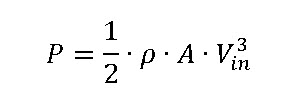Team:Valencia/Windmill
From 2010.igem.org
(New page: __NOTOC__ </noinclude> {{:Team:Valencia/head}} <div id="HomeCenterB"> {{Team:Valencia/to_wb}} <div id="Titulos"> Windmill </div> </noinclude> == Theory == The power of the wind passing pe...)
Newer edit →
Revision as of 00:33, 28 October 2010
Time goes by...
(El tiempo pasa...)
Follow us:

Our main sponsors:

Our institutions:

Visitor location:
» Home » The Project » Creating Technologies » Microbial Albedo Recorder
Windmill
Theory
The power of the wind passing perpendicularly through a circular area is:
Where
- P is the power of the wind measured in W
- ρ is the density of air measured in kg/m3
- v is the velocity of the wind measured in m/s
- A is the analyzed area
The Betz’s Law demonstrate that the power that is possible to achieve from the wind is:
Therefore the power generated depends on the velocity of the wind passing through the turbine. It can be deduced that maximum power produced by a wind turbine is:
If we adapt this equation to our wind turbine, we need to add some parameters in order to study the interaction between the wind, our propellers and the motor.
Where r is the propeller´s length.
As you may see, power depends on wind speed and helix length
Construction
In our first attempts we tried to connect a small propeller directly to the motor. Unfortunately, the power produced was practically none because of the small size of the propeller. Remind that the power has a strong relation with the propeller length. Therefore, our next step was to increase the propeller size. With this modification we obtained a maximum power of 150mW.
After that, we deduced that the problem arose from the motor, which was not capable of generating enough power. This occurred because we used a DC current motor which works with maximum efficiency at high turn speed. Therefore, connecting the motor directly to the propeller the system was not reaching a high turn speed so the produced power was very low. Hence, the solution was adding a gearbox system able to multiply the turn speed on the motor shaft. This solution forced us to install a new propeller with a much wider area in order to get a higher starting torque.
Therefore:
We tried with different relations until we found the one that best suited our motor, which was 5:1.
 "
"


